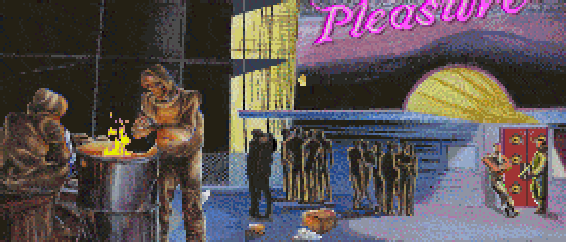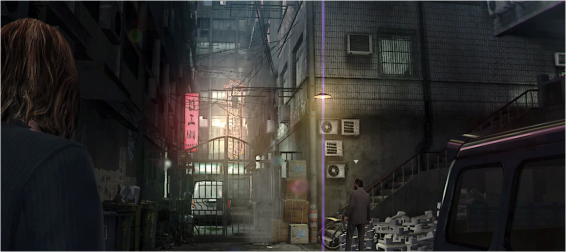
My Urban Design and the Creation of Videogame Cities talk from Develop: Brighton 2017 now handily available in the form of a slightly edited and abridged article. Huzzah! The video complete with Q&A --for those who attended the 2017 conference-- is available here. More information on the subject and on my work on virtual urbanism can be found over at my game-cities.com site.
This talk article, which I've tried to fill with as much useful information as possible, is an attempt to provide game designers and world builders with a spectrum of tools, ideas, and ways of thinking that will improve their game cities and interactive urban environments.
An attempt to help things move even further from the simplistic banality of ancient Police Quest-esque cities.

Urbanism, you see, both actual and imaginary, is incredibly complex, but I do hope that enough ground and most of the basics will get covered.
Unlike the majority of artists who get to do most of the interpretation of cities for their audiences themselves, in games we can only do part of this interpretation. The rest is up to the players; it is they who get to directly experience our virtual environments, and assign value to them.

Players get to decide whether our old fashioned, working class fish shops are brutal, backwards, noble or picturesque. They get to frame them, play with them, hide behind their benches, or totally ignore them while shooting things. We can only provide them with something lovely and convincing. Something believable. Something that even when barely registering will feel real.
To achieve this, what we actually have to do is provide players with places that --first and foremost -- make sense. And this is actually the most important rule to designing a good game city:
Game cities must always make sense.
Realism, you see, leads to believability, which in turn leads to immersion. A feeling of presence. Of being there in space.
Also, as I kept telling urban planning students for years, and am bound to keep on telling world builders, please, do not think like architects. That's the wrong scale when approaching settlements. Think like urban planners. Even better think like geographers and planners.
And, while you are at it, do let your city tell its story. Just like Los Angeles starred in the classic noir movies, your game's city can and should influence both your game's story and how it plays. Besides, researching your setting and trying to get to grips with its urbanism is bound to give you a lot of fresh ideas and solutions.
A city, you see, is not merely the sum of its walls, roads, buildings, and infrastructure. It is much more than its facades and landmarks. It is even much more than its roads and land use plans.

A city is the humans living in and using it. The animals too. A city is everything that happens within it. Everything that shapes and is shaped by it. A city is a huge, complex, dynamic stage for human life. For activity, and drama.
A city is its people, and how they dress. It is its economy, its rumours, hills, monuments, sounds, sky, traffic, buildings, power structures, the ways people get access to drinking water, religion, and a myriad other things, but above all, a city is its functions.
Now, I will of course be returning to the crucial subjects of urban functions, but first I'd rather briefly discuss some of gaming's most intriguing and inspiring cities.

The first one has to be Bioshock's Rapture. Not only is it brilliantly imaginative, utterly exotic, and unique in its underwater beauty, but I also consider Rapture an iconic place realistically organized around its guiding ideology. It is, admittedly, neither a complete nor a perfect design --no artificial city can ever be-- and its illusion of coherent urbanism is thoroughly helped by a plot that does away with the need for a proper city life, but it really works. And the Art Deco architectural choices are truly apt too.

On the other hand, Bioshock Infinite wasn't as successful, mostly due to unrealistic crowds, and its deeply flawed roller-coaster inspired transportation option. The latter in particular was what broke immersion for me, though I was happy to see several reviewers mention it too.
Interestingly quite a few reviews also picked up the importance of Dunwall's economy in Dishonored.

Like Bioshock Infinite, Dishonored doesn't take place in an empty city. Unlike Infinite, Dishonored's Dunwall is a living, breathing place. It's got some wonderful architecture, and an all influencing and original whale-based economy around which much of the city, and its everyday life have been constructed. Also unlike Infinite, Dishonored wisely sets its battles in places mostly populated by guards, safely outside the uncanny valley.
What both games do really well, is providing us with a sense of stark, spatially organized class divisions, and exciting (if hateful) civic politics.

Another clever choice is that the huge scale of Dunwall is mostly implied, and not modeled in detail in its complete and very expensive entirety. It is beautifully shown off from afar while travelling in boats or while looking from the shores of the river.

Another one of my favourite game cities would have to be Kane and Lynch 2's Shangai. A place that felt incredibly lived-in, dynamic, packed with detail, a strong sense of locality, and thus real. Palpable almost. Much was shown and even more was implied via carefully crafted routes through backstreets and informal markets, and by utilizing skyscrapers that could be glimpsed in the backgrounds, or by emphatically showing that the city was a place under heavy construction.

More ambitious and an actual open world, Assassin's Creed's London is a truly impressive, 100% walkable game city. It only models part of the of the 19th century metropolis of course, but manages to cram in all major characteristic districts types, as well as many recognizable landmarks. It is a fine and very expensive abstraction of a city that existed, and one that is vastly helped by incorporating a lovely to look at and relatively cheap assets-wise river. Assasin's Creed doesn't forget to include upper, middle, and working class areas, historically accurate industrial spaces located both inside and separately from poor residential quarters, pastoral suburbs and parks, and even utilities such as railways, hospitals etc.
I would have probably gone for slightly narrower roads, and a greater mixture of land uses myself, but, admittedly, this is quite an amazing city. Oh, I would also fog up the sky a bit more too! Like this:

The lovely if extremely compact Prague from Deus Ex: Mankind Divided is also worth a mention, as is CD Project's forthcoming and apparently terribly ambitious sci-fi city of Cyberpunk 2077.


But, what we really have to spend some time on is Half-Life 2 and City 17. A hugely successful urban environment to play in that, believe it or not, is already 13 years old.

And yet it remains one of the most believable, coherent, economically designed, and memorable urban environments ever crafted. The imposing alien tower, the Combine Citadel --a major, central landmark-- instantly sets the tone and always keeps players oriented. It makes the well designed city easier to navigate in combination with minor landmarks (such as the train station), and acts as a defining juxtaposition of Combine and Human architecture and space organization logic.
Said landmark also works as the latest addition to the historical layers of the city. City 17 has different tech-levels co-existing, buildings of various ages, regimes, and styles, decaying houses, alien constructs, and, importantly, everything placed in it feels as if it has been placed there to serve some personal or collective purpose. Either for residents past and present, or the occupiers. The fact that the urban environments have been based on obviously extensively researched cities such as Sofia and Belgrade obviously helped a ton too.
What's more, the urban layouts and spatial organizations selected for the place, serve well as battlegrounds, what with City 17's courtyards, canals, and streets of varied sizes. Even the sky and climate feel right and not just something randomly chosen. As for the plot, it supports not having too many 2004 tech taxing people around, while blocked off areas due to security reasons, and long canals, help imply a civic size that isn't fully modeled.
In a nutshell, here are the major successes of City 17:
Major Landmark: Citadel
Obvious Historical Layering
Extensive Research & Use of Actual Urban Configurations
Urban Layouts that Support Level Design




































